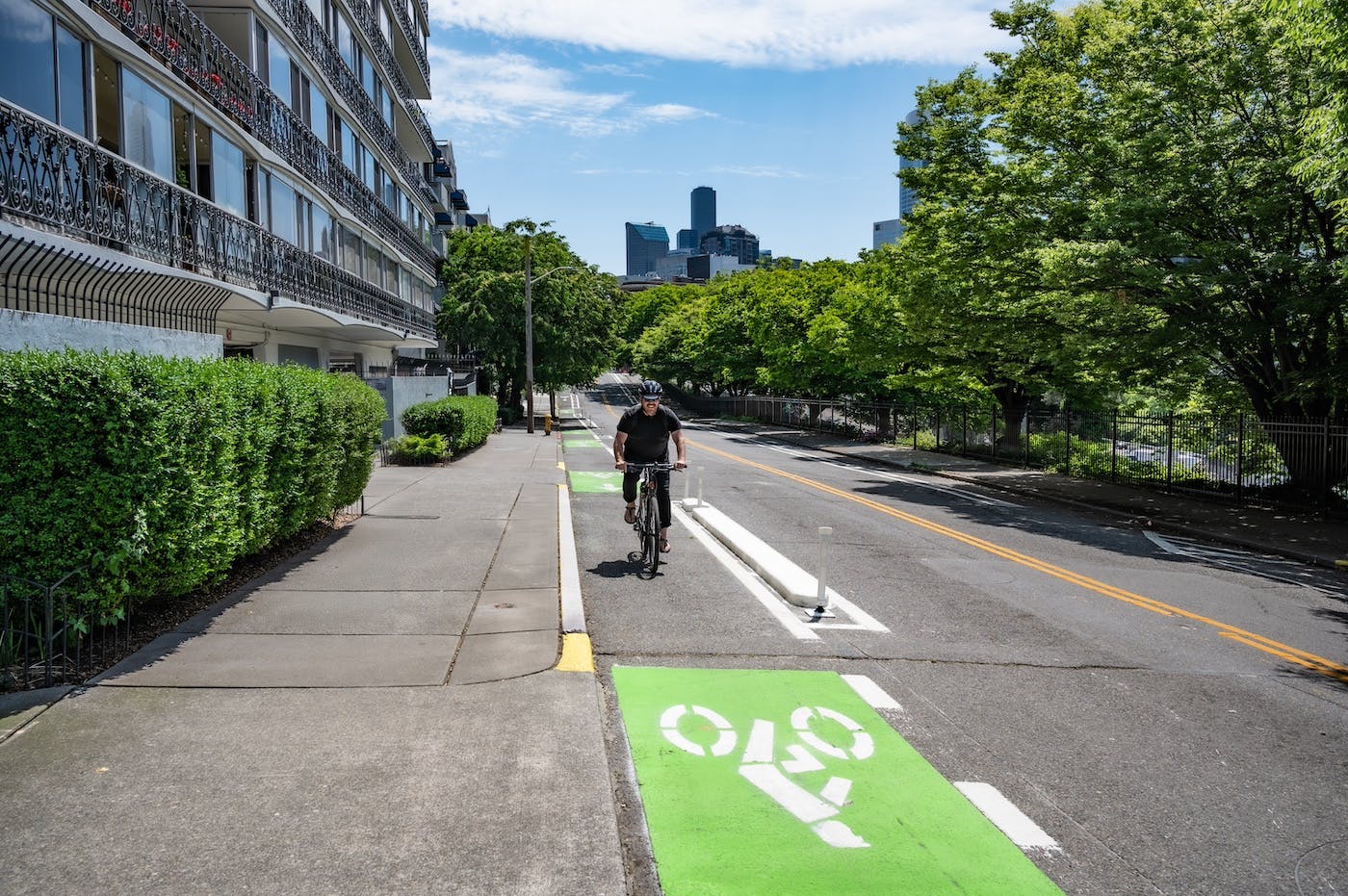Bicycling Is Improving in Cities Across the U.S.
By: Rebecca Davies, City Ratings program director

With seven years of City Ratings results, dive into the data and explore how bicycling has changed in cities nationwide since 2018.
PeopleForBikes’ seventh annual City Ratings showcases cities across the country investing in safe streets for bicycling. Our City Ratings program ranks cities based on their Bicycle Network Analysis score, which measures the quality and connectivity of a city’s bike network based on six key factors: safe speeds, protected bike lanes, reallocated road space, intersection safety, network connections, and trusted data.
By combining the results from all 2,000+ U.S. cities in this year’s analysis with past years’ data, we created a holistic summary of national progress towards making U.S. cities great places to bike.
The 2024 City Ratings includes 2,300 U.S. cities, an increase of 816 cities over 2023. PeopleForBikes adds cities to our City Ratings based on requests we receive throughout the year (this year’s request deadline was February 26). You can request to have your city added to next year’s City Ratings on our website.

Of the 816 newcomers to the 2024 City Ratings, 708 are small cities and 108 are medium cities. Previous City Ratings already included all of the largest cities in the country, so the only additions to the large city category are cities experiencing population growth.

For the second year in a row, Minneapolis claimed the top spot for large cities (those with populations larger than 300,000). The second and third place cities, Seattle and San Francisco, swapped places since last year when Seattle came in third and San Francisco ranked second. St. Paul, Minnesota, demonstrated the Twin Cities’ joint commitment to bike infrastructure, rising from 7th place in 2023 to 4th place in 2024. Denver moved into the top 10 large cities from its 11th place rank in 2023 while Detroit fell out of the top 10.
Among medium-size cities, the city of Cambridge, Massachusetts, continued its impressive trajectory, climbing from 12th in 2023 to 2nd in 2024. Anchorage, Alaska, also scaled the ranks from 56th in 2023 to 8th in 2024, which is the result of improved OpenStreetMap data and the city’s growing network of multi-use paths.
Six newcomers joined the top 10 small cities, including the highest scoring city in the country, car-free Mackinac Island, Michigan, located just north of the state’s mainland in Lake Huron. Harbor Springs, Michigan; Springdale, Utah; Washburn, Wisconsin; Fort Yates, North Dakota; and Sewanee, Tennessee, are also new to the City Ratings and the top 10. Perennial leader Provincetown, Massachusetts, gained eight points, rising from 88 out of 100 in 2023 to 96 in 2024, landing the city in second place among small U.S. cities.

The average score among all U.S. cities is 25 out of 100, two points higher than the average in 2023. The average scores among all top 10 cities also improved in every size category.

Viewing city score averages by state, Alaska scores highest with an average population-weighted city score of 59 out of 100. North Dakota comes second with an average city score of 50, followed by Vermont (49), New York (47), and Wisconsin (46).

Eight percent of U.S. cities score 50 or higher in this year’s City Ratings, compared to 5% in 2023. The growth in cities scoring higher than 50 points reflects nationwide bike network improvements and the addition of high-scoring newcomers. Like last year, more than half of U.S. cities score between 10 and 30 points. Fifteen percent of cities score under 10 points.

Between 2023 and 2024, 80% of U.S. cities improved their City Ratings score. Two percent of U.S. cities improved their score by more than 10 points. Comparing results between 2020 and 2024, 18% of cities improved by more than 10 points.

All of the top large cities improved by at least one point between 2023 and 2024. Minneapolis and St. Paul improved significantly between 2018 and 2024 through a combination of lowering speed limits, building bike infrastructure, and improving OpenStreetMap data.

By building protected bike lanes, lowering speed limits, constructing safe crossings, and improving OpenStreetMap data, the 20 cities listed below achieved the largest score improvements among all cities ranked in both 2020 and 2024. Prior to 2020, our analysis assumed all residential streets were 25 mph and therefore low stress. In 2020, we modified the analysis to customize residential speed limits based on city and state policy, which is why we use 2020 as a baseline for comparison to later years.

Across seven years of results, select cities are distinguishing themselves as leaders in building safer streets for bicycling. Still, most U.S. cities have a long way to go and need to prioritize the policies and practices that will accelerate bike network buildout.
Related Topics:
